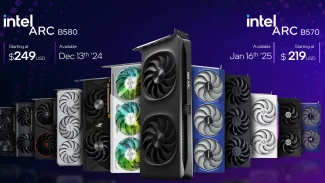Názory k článku Procesory Intel Lunar Lake budou mít o 50 % lepší výkon než Meteor Lake. Díky výrobě u „nepřítele“?
-

Momentalne ma Intel cca 20-30% horsi perf/watt v nizsich TDP. Takze asi preskoci Zen4 a bude to zajimave utkani se Zen5 :)
-
-

Tak ono se vzdycky muze neco povest, cim ta firma utece konkurenci. Pak zalezi, jak ta druha firma zareaguje.
Kdyz bych mel kristalovku, tak si zavestim, ze LunarLake a Zen5 v tech nizkych TDP na tom budou podobne, LunarLake mozna o kousek lip. Preci jen bude mit Intel vyhodu o generaci lepsiho procesu u TSMC a pokud ani s tim nebude mit aspon v nejakem parametru lepsi produkt, tak uz fakt nevim :)11. 3. 2024, 11:14 editováno autorem komentáře
-
-

Dvakrát víc ALU mít nebude (nynější jádro Intelu má 5, ta nový architektura taky může mít víc...), teda pokud se nepočítá 2x šířka SIMD jednotek...
-

"The "High performance" of the title and the "mobile" in the article sounds strange.
Most notable, the fact that Intel use TSMC N3P instead of the superior-multi-pluri-acclamed Intel 18A seems to implicitly means that TSMC is better on efficency, or that Intel have problems with future nodes"No.
Intel won't use Intel 3 because servers will take up all the wafers, and even if they have some left over, N3 is better for lower power. 20A can't be used because 20A is just like Intel 4 in that it doesn't have all the libraries necessary for I/O and SoC tiles, so they can't use that. 18A can't be used since Lunar Lake is coming this year and is way too late.
Arrowlake can use 20A because it'll have a different tile configuration, similar to Meteorlake and can use Intel process just like Meteorlake does. There's no doom and gloom anywhere here.
This is so Intel can de-couple process from design which means process won't hinder design and design won't hinder process. At this point process team is better and design team is questionable, but it is what it is.





























